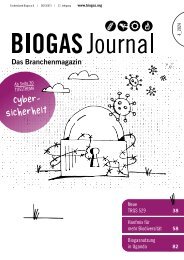You also want an ePaper? Increase the reach of your titles
YUMPU automatically turns print PDFs into web optimized ePapers that Google loves.
English Issue<br />
Biogas Journal<br />
| <strong>Autumn</strong>_<strong>2017</strong><br />
Table 3: Costs of maize stover silage in direct competition between grain maize<br />
and silo maize cultivation (€ rounded to whole numbers)<br />
Land costs<br />
Contribution to profit from<br />
the sale of grain maize<br />
Processing costs for maize<br />
stover silage “available in<br />
the field” to “free input”<br />
€ per ha € per ha € per ha € per ha<br />
Total costs “free input”<br />
Euro cents per<br />
Nm 3 CH 4<br />
Euro cents<br />
per kWh el.<br />
0 88 243 155 12.5 3.1<br />
250 88 243 405 32.7 8.2<br />
500 88 243 655 52.9 13.3<br />
750 88 243 905 73.1 18.3<br />
1,000 88 243 1,155 93.4 23.4<br />
From an economical standpoint, fermenting the stover<br />
from the grain maize supply should not be disregarded.<br />
Is the fermentation of maize stover silage<br />
also economical under the new German<br />
Renewable Energy Act [EEG] <strong>2017</strong>?<br />
If a biogas plant switches over to the new EEG <strong>2017</strong>, it<br />
must comply with the so-called “maize and grain cap”<br />
(Sec. 39h, EEG <strong>2017</strong>). If the switch is made in <strong>2017</strong>,<br />
the use of maize as the entire plant, grain maize or<br />
husk-cob-meal is limited to 50 percent by mass – until<br />
this cap is reduced in 2021 in two stages to a maximum<br />
of 44 percent by mass.<br />
Biogas plants affected by the cap have to think about<br />
what the next best substrates are after maize silage.<br />
Depending on the region, this may be one of the alternatives<br />
currently under intense discussion (Silphium perfoliatum,<br />
sugar-beets, ...), but also maize stover silage.<br />
If, due to intensive grain maize cultivation near the<br />
biogas plant, there is unused maize stover available,<br />
the switch to EEG should be made without hesitation.<br />
Is the fermentation of maize stover silage<br />
also economical if grain maize is grown<br />
instead of silo maize?<br />
If the maize stover isn’t “there anyway” and “free”,<br />
economic considerations must include the calculation<br />
of the land costs as well as the contribution to profit<br />
from using the grain maize. Without land costs, this<br />
contribution to profit averaged – 87.90 per hectare in<br />
the past five years (2011 though 2015), according to<br />
the LfL online calculator. If the land costs are also taken<br />
into account, the total costs “free input” for a rental<br />
cost level starting at € 350 per hectare are already at<br />
the target specified above of 10 euro cents per kilowatt<br />
hour (see Table 3). That means that the situation described<br />
here only makes sense if sufficient land area is<br />
available at a low cost.<br />
Conclusion: In the cultivation of grain maize, a significant<br />
amount of waste residue in the form of maize<br />
stover is produced. Under the same conditions as in<br />
practice, about 5 tonnes of dry matter were recovered<br />
with dry matter contents, for the most part, of 40 to 50<br />
percent, although the yields can vary widely depending<br />
on harvest conditions. Because maize stover has an<br />
astoundingly high methanization potential, about 80 to<br />
95 percent that of silo maize, it is a promising biogas<br />
substrate.<br />
The methane yields per hectare are about 20 to 25 percent<br />
in comparison with silo maize. Maize stover also<br />
seems suitable for silaging. A crucial advantage is that<br />
the utilisation of maize stover does not require any additional<br />
land area and no production effort is necessary<br />
until harvest time, which results in very low total costs:<br />
4.9 euro cents per kWhel when converted. However, it<br />
is still unclear how the substrate behaves in continuous<br />
feed and if treatment or technical modifications to the<br />
plant are needed at all or starting at a certain amount<br />
used. These questions will be clarified in further trials.<br />
Authors<br />
Monika Fleschhut (M.Sc.)<br />
Bayerische Landesanstalt für Landwirtschaft<br />
Institut für Pflanzenbau und Pflanzenzüchtung<br />
Am Gereuth 4 · 85354 Freising, Germany<br />
Phone: 00 49 8161 71-43 18<br />
e-mail: Monika.Fleschhut@LfL.bayern.de<br />
www.LfL.bayern.de<br />
Martin Strobl (Dipl.-Ing. agr.)<br />
Bayerische Landesanstalt für Landwirtschaft (LfL)<br />
Institut für Betriebswirtschaft und Agrarstruktur (IBA)<br />
Menzinger Str. 54 · 80638 Munich, Germany<br />
Phone: 00 49 89 17 800 474<br />
e-mail: martin.strobl@LfL.bayern.de<br />
18

















